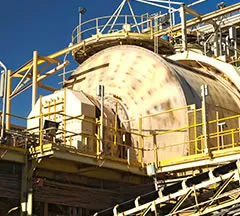Crushing and grinding, also known as comminution, is one of the most energy-demanding processes in mining — consuming up to 50% of a mine’s total energy use and nearly 1% of global electricity. As the industry faces mounting pressure to cut emissions and boost efficiency, AI is emerging as a potential game-changer. But is it always the right solution?
Energy, Wear, and Ore: A Tough Grind
Crushing and grinding are essential to mineral extraction, reducing ore to manageable sizes for further processing. Yet this process poses numerous challenges. ABB’s Wilson Monteiro and Maarten van de Vijfeijken point to several: high energy demands, rapid equipment wear, operational inefficiencies, and increasing ore variability.
Harder ores demand more energy and wear down equipment faster. Meanwhile, declining ore grades require higher throughput, meaning larger, more energy-intensive machines. With so many factors at play, improving efficiency becomes a delicate balancing act.
Enter AI: Smarter Grinding in Real Time
AI and machine learning (ML) offer promising tools to tackle these challenges. According to ABB, there’s no one-size-fits-all fix — but AI is becoming a vital part of the solution.
By analyzing real-time sensor data, AI systems can predict equipment wear, optimize mill load, and adjust operating parameters on the fly. This dynamic control can reduce energy use, increase throughput, and improve ore recovery.
Digital twins — virtual replicas of grinding circuits — allow operators to test different scenarios safely before applying them in real operations. AI also enables predictive maintenance, detecting potential failures before they cause costly downtime.
Monteiro highlights the Gearless Mill Drive (GMD), which improves uptime by removing mechanical drive train components and streams real-time data for AI analysis. ABB’s new GMD Copilot, an AI-powered assistant, optimizes GMD performance for greater efficiency and lower emissions.
AI Isn’t Always the Answer
Despite AI’s potential, Rockwell Automation’s Grant McHenry advises caution: “The key is to understand the miner’s problem first — only then can the right technology be chosen. Sometimes AI is the answer, sometimes it’s not.”
McHenry advocates starting with a detailed assessment of the operation, then applying mature solutions like Model Predictive Control (MPC) — a form of advanced process control (APC) that uses mathematical models to predict and optimize outcomes.
Rockwell’s Pavilion8 MPC has already been used in several crushing and grinding operations, including one with Newcrest Mining at its Cadia gold mine in Australia. By analyzing historical data, Rockwell identified key process variables and used MPC to stabilize and improve throughput while managing multiple variables in real time.
Beyond AI: Traditional Tech Still Matters
While AI grabs headlines, other techniques continue to play vital roles in improving crushing and grinding:
- Ore pre-concentration using sensor-based sorting reduces waste before grinding.
- Optimized blasting ensures the right fragment size for easier crushing.
- Discrete element modeling customizes liners and processes based on specific ore bodies.
- Simulation tools help tailor designs and operations for optimal performance.
Mark Hurley of Bradken (a Hitachi subsidiary) adds that matching wear liners to the ore can improve throughput, extend equipment life, and enhance recovery.
The Road Ahead
As AI tools become more integrated with traditional APC systems, their role in mining is expected to grow. Companies like H-E Parts International believe ML is key to unlocking new levels of asset optimization by predicting outcomes and fine-tuning parameters.
Still, experts agree: AI is just one tool in the kit.
“There’s always more than one way to solve a problem,” says McHenry. Whether the goal is to increase throughput, reduce energy use, or boost yield, miners should focus on the specific challenge — and then choose the right technology, AI or otherwise.


